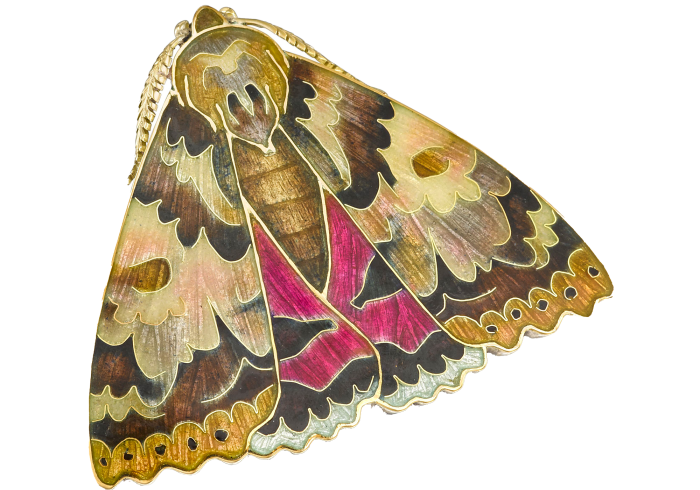Shining examples of the art of enamelling on show in London

Unlock the Editor’s Digest for free
Roula Khalaf, Editor of the FT, selects her favourite stories in this weekly newsletter.
A short walk from Goldsmiths’ Hall in the City of London is the site of one of the most extraordinary hoards of jewellery and gemstones ever found. It was uncovered in 1912 beneath a row of buildings on Cheapside owned by the Goldsmiths’ Company. Among the pieces were some of the rarest examples of enamelled jewellery of the 16th and 17th centuries — gold chains embellished with enamelled floral links, as well as enamelled rings and pendants.
They were examples of a technique of fusing finely ground glass to metal and other materials that goes back to ancient Greece and is still being practised and reimagined by contemporary jewellers. And it is this tradition that is being celebrated at the ongoing Goldsmiths’ Fair, in a special exhibition to accompany the 2024 curated selection of some of the finest designers and contemporary metalsmiths working in the UK.
The exhibition, in the Front Hall, which you pass through on the way to the selling fair, contains examples of the different ways enamelling techniques have been used in jewellery and hollowware since the 1960s — all drawn from the extensive Goldsmiths’ Company collection.
The Dark Crimson Underwing Moth pin (2021) — by Fred Rich, a veteran master of traditional enamelling techniques who works from a studio in East Sussex — is made with gold wire just 0.05mm thick, using a technique he calls “micro-cloisonné”. It is a relatively small piece among a glorious collection of exhibits that include rings, neckpieces and bracelets, as well as cups, beakers and bowls, but it holds the attention. As does the Sheila McDonald bird brooch (2011) — a quieter but no less memorable example of a different approach to enamelling.

A set of three floral brooches (2017) in enamelled silver, by Jonathan Boyd — an artist-jeweller who is also head of applied art at the Royal College of Art in London — show a darker, more modern intensity that represents a different approach to enamelling.
From the Front Hall the grand staircase leads up to the main rooms, where this year’s fair exhibitors are set up and where, in the second and final week of the event, there are interesting and covetable examples of the enameller’s art.
Among them is Yinglong Li, known for his mastery of plique-à-jour, where the enamel is applied in cells. It is similar to cloisonné, but without the backing, and is rather like stained glass. His recent groundbreaking research for his PhD at Birmingham City University’s School of Jewellery uses enamel as a bonding agent, as well as a decorative device, through the use of lasers.
He calls his collection of brooches made using this technique MTG, inspired by “mind the gap” alerts on the London Underground. A silver grid of balls are connected by yellow, green, blue and red enamel that he describes as creating a “special shadow effect”. His designs are an attempt to integrate eastern and western cultures, while pushing the boundaries of what enamel can do.
Li’s eastern influences stem from China. Another exhibiting jeweller, Jane Moore, who also puts enamel at the heart of her work, finds her inspiration in Japan. Both countries have a tradition of fine, decorative enamelling going back centuries. “Simple traditional Japanese artefacts and textiles embellished with tiny floral motifs” have been the inspiration for her “decades of practice”, she says. Moore uses traditional enamel techniques alongside photo etching, laser cutting, and fine enamel transfers. The results are pieces featuring a rainbow of translucent enamel “jewels”, given life by textures and patterns created in their silver backing.

Although Emma Louise Wilson finds her inspiration in the seascapes of the Aberdeen coastline, the delicate watercolour effects she creates for her silver and enamel brooches, rings and bowls have a Japanese feel to them, too. Through her jewellery and other pieces, she is trying to capture the feelings of “beauty and quiet solitude” these moody vistas of Scotland evoke. There is a timelessness to her work.
Enamel is all about colour and the most vibrant examples at this year’s fair are from Alice Cicolini, who has used traditional vitreous enamel in her designs, inspired by India, Persia, and the Silk Road. She has also led the way in reimagining the use of enamel in contemporary jewellery. She spent the past few years exploring the potential of “cold” lacquer enamel with Stanislav Reymer, her London-based enamel master.

“Stanislav is a tinkering genius and has developed a series of enamel techniques with me using this material,” says Cicolini. “I have never entirely understood the received wisdom that vitreous is a ‘high craft’ and lacquer enamel is in some way ‘lesser’ — it’s really about who uses it and what they choose to do with the material.”
Because lacquer enamel is not heat-fired, the colours do not merge together and that allows her to emulate the swirling pools of colour that are the distinguishing characteristic of marbled end papers that feature in some of her work.

The opportunity to play with colours, and merge and combine freely, that “cold” enamel offers, is also seen in the work of artist and jeweller Inca Starzinsky. Her Float collection is a colour-drenched celebration of childhood dreams, whose melting illusion gives the impression of floating shapes — some organic, others forming words — that belie the satisfying solidity of the brass and silver brooches, rings and bangles when you pick them up.
As with Cicolini’s work, colour is everything. Cicolini also amps up the impact of enamel with gemstones and this is also the case with Ingo Henn, whose 18ct white gold Radiance bangle is one of his standout pieces: alive with swirls of pink, red and blue enamel. For him, “rare coloured gems always form the focal point” and, in the case of the Radiance bangle, it is a shining rubellite cabochon stone.
Goldsmiths’ Fair runs to October 6
#Shining #examples #art #enamelling #show #London






